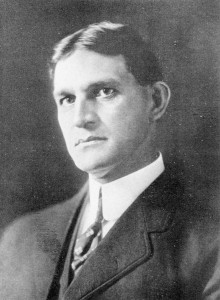Davison McDowell Douglas, 1911-1926

June 20, 1869 – August 1, 1931
Davison McDowell Douglas came to PC in 1911 from the Maryland Avenue Presbyterian Church in Baltimore. He was a graduate of Davidson College and Columbia Seminary, received an MA degree from the University of South Carolina, and did additional post-graduate work at Princeton and Johns Hopkins. During his fifteen year tenure, both the student body and the size of the faculty tripled in size, the faculty elevated to twenty members. Four new buildings were completed, Spencer Dormitory (1912), Wm. P. Jacobs Science Hall and Library (1915), Smyth Dormitory (1924), and Leroy Springs Gymnasium (1924).
A man of vision, President Douglas engaged Charles W. Leavitt, Jr. of New York City, a landscape engineer of national reputation, to lay out a plan for the West Plaza during his first year as president. The campus was described as “four buildings set back in a streetless field called a campus” (In Memoriam: Davison McDowell Douglas, University of South Carolina, Columbia, SC, January 1932, 21). A cotton field and Professor Martin’s cow barn near Neville Hall were replaced by a green plaza with avenues on either side. Scores of trees were planted giving the campus much of its present beauty (Hammet, Spirit of PC, 32). Mr. Leavitt returned to campus often as a visitor and friend of Dr. Douglas.
The endowment increased during the Douglas years from $5,000 to almost $300,000. President Douglas “believed in the value of physical activity as an integrated part of the educational process … fundamental to this should be an expanded program of sound intercollegiate athletics which would make PC more attractive to young men,” and the college lifted the ban on intercollegiate football in 1913. (Hammet, Spirit of PC, 34).
The ban on intercollegiate football by the Board of Trustees beginning in 1909, stemmed from a lack of eligibility requirements and uncontrolled practices where men were hired to play on teams. The baseball schedule was limited to ten games, seven of which were to be played on home ground. Rules also allowed faculty members to play on teams. After the ban on intercollegiate football was lifted in 1913, the trustees appropriated $1,000 to re-condition a field for football. The field was located where Springs Gymnasium, built in 1924, now stands.
Leaving PC a much stronger college, Dr. Douglas resigned in 1926 to become the president of the University of South Carolina. A. E. Spencer once again served as interim president for six months. Davison M. Douglas died in Columbia in 1931.
